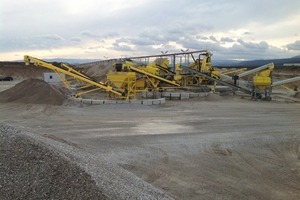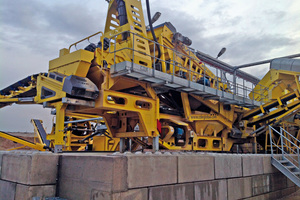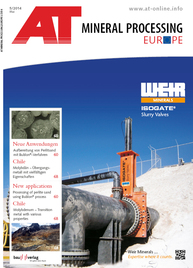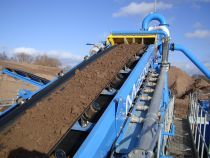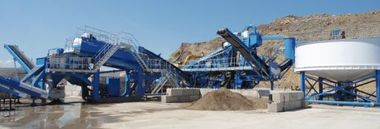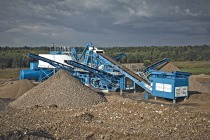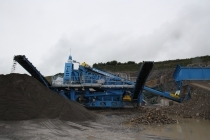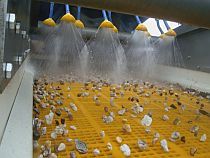Pehofer expand sand and gravel production capability
Pehofer GmbH have invested in a new modular gravel washing plant from CDE Global (Fig. 1) and held open days at their new site near Wiener Neustadt in Lower Austria on 29th and 30th April 2014 to demonstrate its capabilities. Visitors could view the washing plant in operation and also had the opportunity to discuss the system with representatives from Pehofer GmbH and CDE Global.
The plant includes the M2500 E3X mobile washing plant and an AggMax 153 semi-mobile logwasher and processes 225 t/h of limestone raw material. The washed sand and gravel from the new plant is used by Pehofer in their own ready-mixed concrete production plants, and the products are also offered for sale on the market. Pehofer purchased the new site in order to ensure complete independence in the area of sand and gravel for decades. “Investment in the new washing plant has given us greater control over the quality of the sand and gravel products used in our concrete production. The plant from CDE also includes a degree of flexibility in relation to the sand and aggregate products that will increase the efficiency of our operation and allow us to offer best value and quality to our customers”, explains Helmut Pehofer, a partner in Pehofer GmbH.
Pehofer GmbH is an Austrian family business founded in 1979. The main activity of the company is the supply of ready-mixed concrete, as well as sand, gravel and grit for private, commercial and public construction sites. A partner company, BT3 is responsible for monitoring quality at the Pehofer concrete and gravel works and performs all product testing and concrete/gravel technology services to ensure the high quality requirements are met. The company’s vertical integration strategy has been in place since the year 2000 and has seen the construction of two new concrete plants in Breitenau (2000) and Pinggau (2004) in addition to the purchase of the new gravel site in Weiner Neustadt, approximately 50 kms south of Vienna.
When Pehofer began looking for a supplier for the new gravel washing plant at Wiener Neustadt they had some very specific requirements in order to ensure that the sand and gravel production process at the new site was designed with efficiency in mind. This not only related to the performance of the washing and classification plant but to how its operation would be managed as exploitation of the new resource developed in the years ahead. “We required that the plant be sufficiently mobile that we would be able to move it as extraction progresses. We anticipate this will happen every two or three years”, explains partner Mr Peter Pehofer. The plan to move the plant as extraction progresses is designed to minimise the costs of transport movements at the new site.
Raw material is delivered to the feed hopper of the M2500 E3x via a ramp. The plant accepts 0-100 mm material with the hopper grid rejecting any oversize. This material is then delivered to the aggregate screening phase which utilises a Prograde P2-75 double deck rinsing screen. The top deck sends the +32 mm material to a stockpile with the 4-32 mm material sent to the AggMax 153 via another integrated conveyor on the M2500. The 0-4 mm material is sent to the EvoWash sand washing plant integrated on the M2500 chassis (Fig. 2).
The AggMax is required in this instance to effectively remove raw gravel material from the clay and fine particles which bind the material together. As material enters the AggMax it is subjected to a high level of attrition from the integrated Rotomax logwasher. In this instance a RotoMax RX153 is employed which has a capacity of 150 t/h. The scrubbed 4-32 mm material is then discharged onto a triple deck horizontal sizing screen for classification into the required aggregate grades. The waste water containing the liberated fines and clay is returned to the sand washing phase on the M2500 to maximise sand recovery. As the feed material contains a small proportion of material in the 0-4 mm range this step is critical to ensuring production of a manufactured sand product that meets the required standards for use in concrete.
The plant is configured in such a way as to allow three production modes each delivering a different suite of final sand and aggregate products according to the specific requirements of Pehofer at any given time. This is achieved without any requirement to change screen media and is facilitated by the introduction of a number of diverter chutes and the introduction of two radial stockpile conveyors.
In the primary production mode the plant produces a 0 - 4 mm sand as well as 4 - 8 mm, 8 - 16 mm and 16 - 32 mm aggregates and a +32 mm oversize product. In secondary production mode the final products are a 0 - 8 mm, 8 - 16 mm and 16 - 32 mm with the +32 mm oversize. This is facilitated by diverting the scrubbed 4 - 8 mm product from the AggMax and combining it with the 0 - 4 mm material from the M2500. Tertiary production mode sees the 0 - 4 mm material from the M2500 combined with the 4 - 16 mm material from the AggMax to produce a 0 - 16 mm and 16 - 32 mm material and a +32 mm oversize. A diverter chute on the horizontal sizing screen allows this to happen.
“The ease with which we can move between the various production modes gives us great comfort that we will be able to meet our specific requirements in relation to final product specifications as dictated by our gravel and concrete clients” says Peter Pehofer. “These changes are achieved very quickly which maximises plant production and minimises the level of operator intervention required.”
//www.pehofer.at" target="_blank" >www.pehofer.at:www.pehofer.at; //www.cdeglobal.com" target="_blank" >www.cdeglobal.com:www.cdeglobal.com

